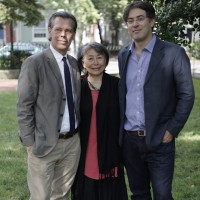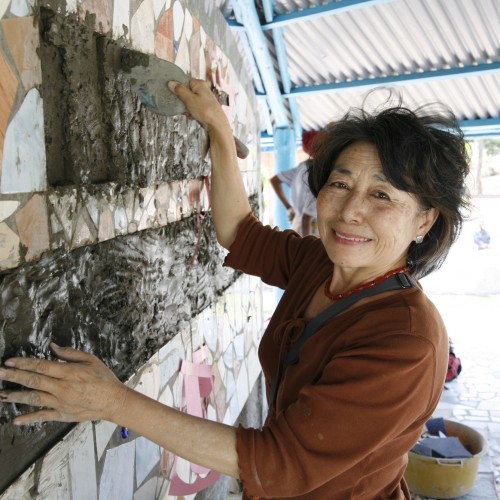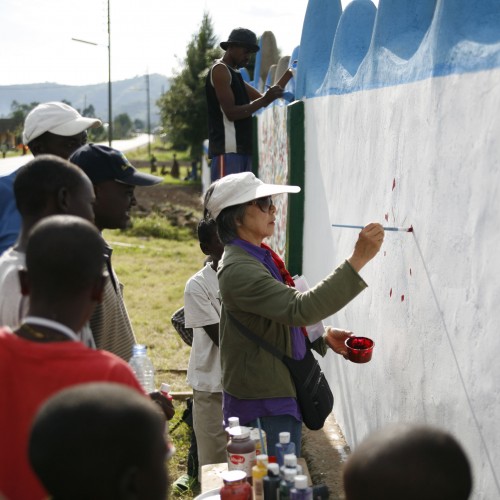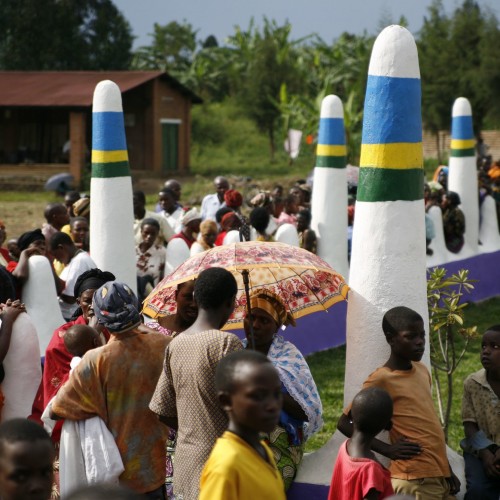Behind The Barefoot Artist
“Beauty is intimately engaged with darkness, with chaos, with destruction. From the depths of darkness, beauty transforms and transcends.”
Thus Lily Yeh explains the philosophy of her art, through which she has engaged denizens of traumatized communities and impoverished areas all over the world for nearly three decades. The Chinese-born, Philadelphia-based artist runs the nonprofit Barefoot Artists (“recognizing that creativity and beauty are powerful agents for healing and change”) and is the subject of new film The Barefoot Artist, co-directed by documentarian Glenn Holsten and her son, Daniel Traub, a photographer and cinematographer. (The two previously collaborated on OC87: The Obsessive Compulsive, Major Depression, Bipolar, Asperger’s Movie, among other projects.)
The film combines two threads: first, it’s the story of Yeh’s development as an artist and her work with various communities. There’s footage of the Village of Arts and Humanities in North Philadelphia, which Yeh created out of an abandoned lot; her transformation of a garbage/hospital dump in Korogocho, Kenya, into a vibrant environment of communally-produced murals and sculptures; and, most poignant, scenes of a genocide survivors camp in Rugerero, Rwanda. There we witness deadened souls who have suffered unbearable loss come alive by telling their stories through drawing and painting, under Lily’s tutelage.
The film’s second thread is Yeh’s exploration of her family, including a hidden side. Her desire to heal wounds drives the search for her beloved father’s “first family,” the wife and children he left behind to marry her well-born mother. The result is a beautifully shot portrait of a remarkable artist and human being.

Glenn, you began documenting Lily in the 1980s, when you made a short film for public television about the Village of Arts and Humanities.
After I did the Village video, I became sort of an adjunct staff member of the Village. I taught young kids video production, and poetry — which is kind of a laugh because I’m not a poet; we started making video poems together. I stayed connected with Lily, had many adventures with her, went to Kenya with her because she was doing the work in Korogocho. We became good friends.
When did you start working with Daniel?
Actually Daniel interned with me at WHYY, the PBS station in Philadelphia, when I was on staff there, but we also did a documentary short in Soviet Georgia about Lily’s project there in an orphanage; it was a terrific way to work together.
What was the genesis of The Barefoot Artist?
Glenn: Lily was going on this family journey back to China and I asked if I could join her. Daniel was living in China and he’s a terrific director of photography, so I asked him if he was willing to film his family journey; that was the start of the one strand in the film. Then Daniel came back to America after documenting his mother’s work in other places. We decided to team up and create this movie about the two sides of her life.
Daniel: Originally we were both thinking separate films. I was just documenting my mother’s projects around the world, but then realized it could be a larger film. At the time Glenn was doing post-production on the family story; we both sort of realized that we should probably pool our resources and make one definitive film.
Glenn: I remember I was editing the trailer to raise money for the film about the family journey, and I thought, I have to figure out how to tell people about this woman’s amazing artwork. Daniel had just returned from Rwanda and he showed some clips and I thought, “That’s how I’m going to show it.” Because it was really beautiful.
Daniel, at age 12 you took a series of photographic portraits of your grandfather. Was that when you started to seriously pursue photography?
I had been photographing in the streets of Philadelphia, taking architectural pictures; my father is an architect, he got me started in a sense. The series with my grandfather was really the first personal project that I did. It gave me a sense of what photography could do.
Any second thoughts about the personal aspects of this film? Obviously it delves into your grandfather’s life, but also touches on your relationship with your mother.
D: It was an issue. I had never really intended to make a film about my mother, but when I was documenting her work, I became more and more drawn in, it seemed an important film to make. I guess I was a bit resistant; I didn’t want to make it too much about me. I think it helps the film, it gives enough context information. Her story is the central strand; my connection to her and my grandfather are two elements of the story.
G: Daniel’s participation was the biggest issue we wrestled with, and pushed and pulled and played with until we got to a point where everybody thought it was working.
The footage of the survivors village in Rwanda is especially moving; the emotion was so palpable. Was that difficult to shoot?
D: Yeah, it was very moving. I went to Rwanda three times; I developed a relationship with a lot of the people. It was quite overwhelming. I don’t think I did much filming the first time; I was getting a sense of the place and learning about what had happened. I think with filming, you’re sort of hiding behind the camera a little bit, it’s a way to stay disengaged; it’s a kind of a shield, for better and worse. I think that helps me to keep working there.
Having done a sort of art therapy in Philadelphia and other places, Lily was confident it would help the Rwandan survivors even though it’s very traumatic for them at first.
D: I don’t know that she would call it art therapy. It’s more of a methodology that she developed out of her own practice; developed out of working with people. I don’t think she was ever connected with the whole art therapy movement, though there is some crossover.
G: She comes up with ways of connecting with people. Daniel, Lily and I went back to Rwanda to show people in the film the almost-final cut to get their blessing and approval before we shared it with the world, and they were all so happy that their hardships had been documented because they felt that their lives progressed so much since that time in history, they all think that this film could help other people who are going through trauma.
Future film projects?
G: I’ve been working on a film about a mental health community in Philadelphia that has a beauty parlor, Hollywood Beauty Salon; it’s about the men and women in this community on their different paths to recovery, doing these hair and fashion shows. I’m really lucky because Daniel is such a terrific DP; he’s been filming and it’s almost done. It should be finished in the spring (hollywoodbeautysalonmovie.com).
The Barefoot Artist is currently playing at the IFC Center in Manhattan; Daniel Traub’s new book of photography, North Philadelphia (Kehrer Verlag), was published last month.
—Marina Zogbi




